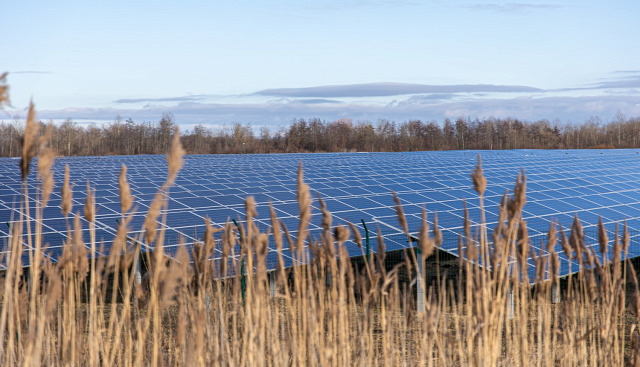
Agrivoltaics, also known as solar sharing or agrophotovoltaics, is an innovative approach that integrates agricultural activities with solar energy production. This emerging concept involves the co-location of solar panels with agricultural crops or livestock, enabling land to be utilized for dual purposes. By combining agriculture and renewable energy generation, agrivoltaics present a sustainable solution to address the challenges of food security, land use efficiency, and renewable energy production.
According to BIS Research, the Global Agrivoltaics Market, which integrates solar energy production with agricultural practices, is poised for significant growth in the coming years, is valued at $1,768.8 million in 2022. The market is expected to expand rapidly, reaching an estimated $15,871.6 million by 2033, growing at a CAGR growth rate of 22.93% during the forecast period 2023-2033.
Maximizing Land Utilization
One of the key advantages of agrivoltaics is its ability to maximize land utilization. Traditionally, large expanses of land are dedicated either to agriculture or solar energy installations. However, agrivoltaics allows for the simultaneous cultivation of crops or pasturing of livestock beneath raised solar panels. This dual land use approach optimizes land productivity and ensures that valuable agricultural land is not sacrificed for solar installations.
Global Agrivoltaics Market Segmentation
Segmentation by Array Configuration:
- Fixed
- Single-Axis Tracking
Segmentation by Photovoltaic Technology:
- Monofacial Solar Panels
- Bifacial Solar Panels
- Translucent Photovoltaic Technology
Segmentation by Site of Installation:
- Grassland Farming
- Horticulture and Arable Farming
- Indoor Farming
- Pollinator Habitat
Access Now: Get detailed FREE research Insights on Global Agrivoltaics Market Research.
Key Market Demand Drivers, Challenges, and Opportunity
Market Driver: Dual-Revenue Streams for Farmers
Agrivoltaic systems enable farmers to use land under solar panels for grazing or crop cultivation while producing electricity. This dual-use model provides additional revenue. They've proven successful for crops like berries, grapes, and shade-tolerant ones such as cauliflower. Studies show shaded crops yield 2-3 times more produce than traditional methods.
Market Challenge: High Installation Costs
Agrivoltaics face barriers due to high installation expenses, mainly driven by costly photovoltaic panels and intricate setup requirements, demanding specialized skills and equipment. Total costs vary based on system size, complexity, location, and components.
According to a report by the National Renewable Energy Laboratory (NREL) in the USA, the installed cost of an agrivoltaic system typically ranges from $2.60 to $4.50 per watt. In comparison, traditional ground-mounted solar systems typically cost between $1.50 to $3.00 per watt. This significant disparity in costs is likely to impede the growth of the Agrivoltaics market during the forecast period.
Market Opportunity: Reduce Emission through Improved Farm Electrification
Agrivoltaics offer carbon sequestration opportunities by integrating vegetation with solar panels, acting as carbon sinks. This process involves absorbing carbon dioxide from the atmosphere, storing it in plant biomass and soil. Thus, Agrivoltaics aid in greenhouse gas reduction and lowering farms' carbon footprint.
Key Market Players and Competition Synopsis
- Jinko Solar
- Invenergy
- First Solar
- Nextracker Inc.
- Iqony Solar Energy Solutions
- BayWa AG
- Sun’Agri
- Lightsource
- Yingli Solar
- Trinsolar
- Next2Sun AG
- SB Energy Corp
- Boralex Inc.
- Berkshire Hathaway Energy
Also Read: All research reports of the Agriculture Industry.
Recent Developments in the Market
In December 2023, Turkey initiated the Agrivoltaics research project, enabling researchers to evaluate both products and the production process. To facilitate this endeavor, researchers introduced tracker systems tailored for crops cultivated through Agrivoltaics methods.
In October 2023, the NSEFI launched the Agrivoltaics Alliance in Delhi, India, aiming to streamline crop production. Through incremental improvements and maximizing natural sunlight utilization, the initiative seeks to reduce production costs and mitigate the prevalence of adulterated vegetables in the market.
Conclusion
Agrivoltaics represents a promising approach to address the dual challenges of agricultural sustainability and renewable energy generation. By harmonizing agriculture and solar energy production, agrivoltaic systems offer a multifaceted solution that optimizes land use, enhances crop yields, generates clean energy, and promotes environmental stewardship. As the world seeks innovative strategies to achieve food security and combat climate change, agrivoltaics emerges as a compelling pathway towards a more sustainable future.

